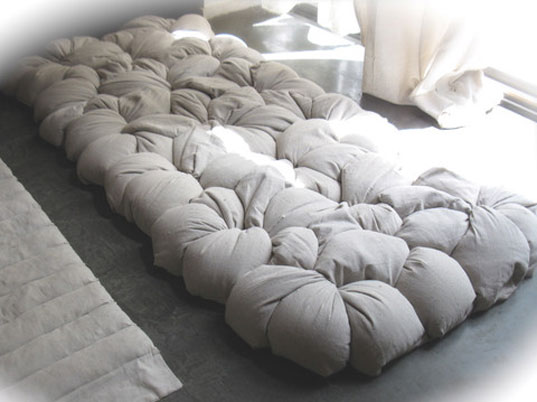Recently it has come to my attention that mattresses are not, actually, vegan. It’s a completely random revelation and it’s also rather surprising in the sense that you think you’re lying on a pile of dead wood, springs (unless you’re one of the Tempurpedic privileged few) and some sort of synthetic or plant-based filling. Well… despite “are mattresses vegan” turning up as a Google search term (spawning this whole tangential exploration of the veganness of mattresses) there hasn’t really been any solid break down of what a mattress is actually made out of and where exactly these non-vegan entities lie so… without further ado:
Why Isn’t My Mattress Vegan?!
First, you’ve got to ask- what is a mattress made from?
Well, the Carolina Mattress Guild (where this lovely image came from) is a company that creates eco-friendly mattresses. The following are some of the components of their mattresses (which follow industry standards):
- Fire retardants are a mandate to include in mattresses and are generally some chemical with rayon (vegan), wool, or silk.
- Wood for the frame (I don’t feel like wood is ever sustainable but it’s vegan)
- Memory Foams seem to be vegan
- Springs are metal
- Latex: (not vegan) which often utilizes casein
What’s in a mattress is pretty straight forward but as with so many things in the common household, not much thought is put into what you’re lying upon every night for years. While choosing a vegan mattress may not be important to you, there are other things to consider like whether or not you’ll be using a chemical flame retardant, organic fibers, memory foam or synthetic or natural latex amongst other things. To know what goes into the actual manufacturing process gives you power over your own environment and can even help you to no longer support industries that may be acting harmfully against the earth or choose a mattress with harmful chemicals inside it.
Finally, in case you’re ready to just ditch your bed altogether, what are alternatives to the mattress that will still provide enough support and comfort but without the side effects or political challenges?
 There’s a “Straw Tick” (see here for instructions) which is a mattress stuffed with straw covered by a thick fabric (like a futon cover). This is a great alternative because it’s all natural, the straw won’t go bad and it’s completely biodegradable as well as easy to dispose of if you have a garden (otherwise maybe you have access to yard waste collection). Additionally, the mattress cover keeps the straw free of dust and mold. 🙂
There’s a “Straw Tick” (see here for instructions) which is a mattress stuffed with straw covered by a thick fabric (like a futon cover). This is a great alternative because it’s all natural, the straw won’t go bad and it’s completely biodegradable as well as easy to dispose of if you have a garden (otherwise maybe you have access to yard waste collection). Additionally, the mattress cover keeps the straw free of dust and mold. 🙂
I found this article on bedding for horses which made some interesting comparisons of materials like peat moss, hemp, straw, and others. All of these items can also be used for people bedding (in a pretty cover perhaps) as well.
Too granola? It’s okay- we just went from typical mattress to peat moss in like 2 sentences. 😉
There are hammocks, tatami mats, the floor, and buckwheat mattresses (like the straw tick above) as well. These are all viable and popular options to the typical “mattress” as listed above. So a better question than “why isn’t my mattress vegan” might be how can you make your mattress vegan? And while you’re making your mattress vegan, you will also be greening up your life- turning your life into something that is much more sustainable, environmentally friendly and progressive as well as much less expensive and therefore much less consumptive than a “mattress” full of flame retardant chemicals and other harmful substances.
And, before I end this piece- briefly consider the ecological toll that a mattress has:
- It is full of chemicals required by law to increase “safety.”
- It generally uses animal products from animals that were treated poorly and have greatly affected their environment.
- It uses springs which come from unsustainable mines and are manufactured and refined in plants that cause environmental destruction.
- It sometimes uses soy which is the leading cause of deforestation in South American rainforests as well as one of the top 5 most used GMO crops in the world.
- It always ends up in a land fill when the usefulness of the product has met its end. It can not be returned to the store and most people do not want to buy second hand mattresses due to a fear of bed bugs.
If you’re concerned, by the way, about bed bugs then think of the fact that you can still get bed bugs irrelevant of what kind of bed you are sleeping in! So really, why isn’t your mattress vegan?
Other Resources:
http://www.nytimes.com/2009/01/15/garden/15mattress.html
http://www.ehow.com/list_6767889_alternative-mattress-ideas.html



what is an organic mattress…
Why aren’t mattresses vegan? What are Alternatives to a Typical Mattress?…